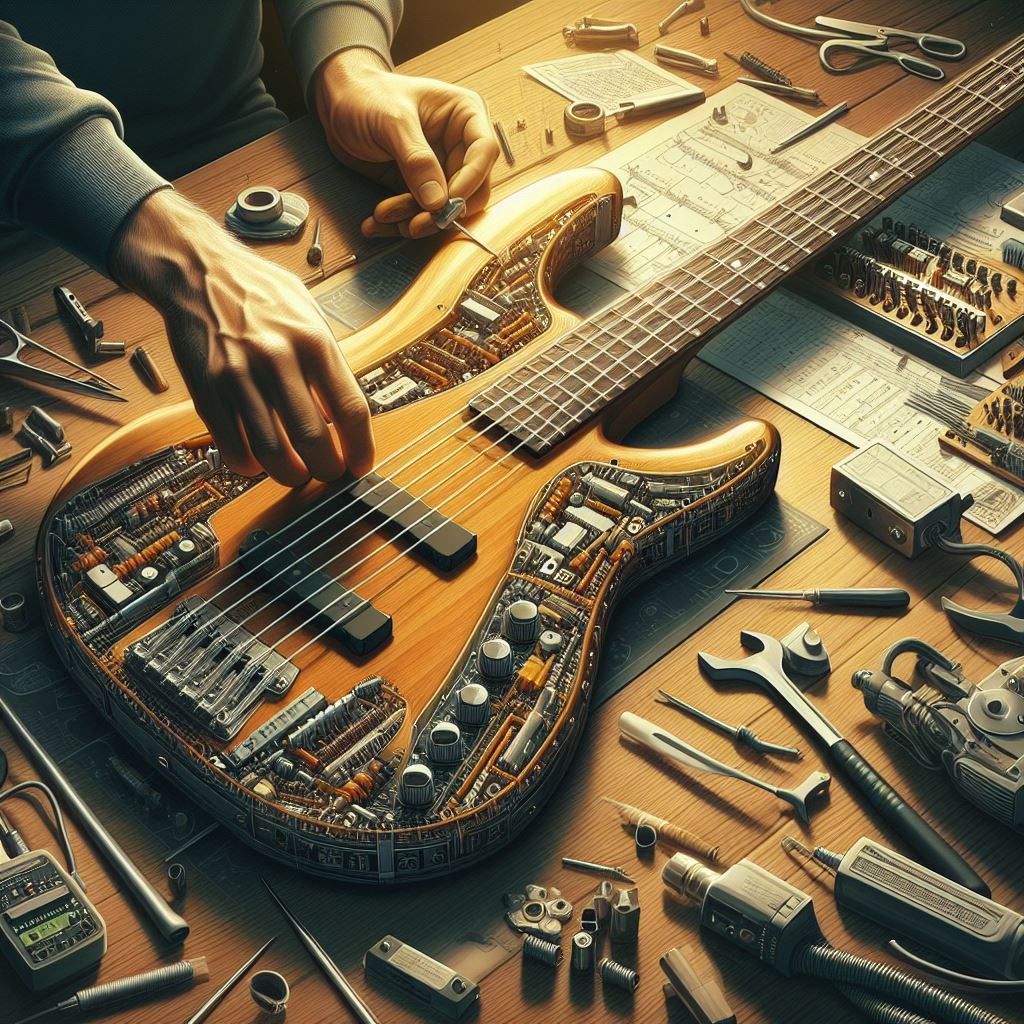Are you a musician looking to enhance your sound and take your bass playing to the next level? If so, then you’re in luck! This article will explore the secrets of precision bass kits and how they can help you build the ultimate bass guitar.
Precision bass kits are popular among musicians due to their versatility, durability, and ability to be customized to fit individual playing styles. Whether you’re a seasoned professional or just starting, building your bass using a precision bass kit can be a rewarding experience.
The beauty of precision bass kits lies in their simplicity. They come with all the necessary parts and components, allowing you to assemble your bass from scratch. It saves you money and will enable you to learn about the inner workings of your instrument.
We’ll explore the critical components of precision bass kits, including the body and neck, electronics, and hardware. We’ll also provide tips on choosing the kit that best suits your skill level and musical style.
So, if you’re ready to unlock the secrets of precision bass kits and build the ultimate bass guitar, let’s dive in!
Table of Contents
Benefits of Building Your Bass
Building your bass guitar using a precision bass kit offers several advantages. First and foremost, it allows you to create a personalized instrument that suits your unique playing style. By selecting the components and materials, you can build a comfortable bass in your hands and produce the desired tone.
Building your bass can also be a cost-effective alternative to purchasing a pre-made instrument. Precision bass kits often come at a fraction of the cost of a high-quality bass guitar, making them an excellent option for musicians on a budget. Furthermore, building your bass can be an enriching experience that allows you to develop a deeper understanding of your instrument.
Choosing the Right Precision Bass Kit
Selecting a suitable precision bass kit is crucial to ensure a successful build. Consider your skill level and experience when choosing a kit. If you’re a beginner, opt for a kit that includes detailed instructions and is designed for easy assembly. On the other hand, if you’re an experienced builder looking for a challenge, you may prefer a kit that allows for more customization and advanced techniques.
When selecting a precision bass kit, pay attention to the quality of the components. Look for kits with high-quality woods for the body and neck and reputable electronics and hardware. Reading reviews and seeking recommendations from fellow musicians can also help you make an informed decision.
Understanding the Components of Precision Bass Kits
Precision bass kits typically contain several key components: the body, neck, electronics, and hardware. The body is the main structure of the bass guitar and is responsible for producing the sound. Choosing a body of high-quality wood, such as ash or alder, is essential as this will significantly impact the instrument’s overall tone.
The neck of the bass is where the fretboard and tuning pegs are located. It is crucial to select a neck that feels comfortable in your hands and suits your playing style. Different neck profiles, such as C-shaped or U-shaped, offer different comfort levels and playability. Consider trying other neck profiles to find the one that suits you best.
The electronics of a precision bass include the pickups, pots, and wiring. These components determine the sound of your bass and allow you to control the volume and tone. Precision bass kits often come with pre-wired electronics, making assembly easier for beginners. However, more experienced builders may prefer to customize their electronics to achieve a specific sound.
The hardware of a precision bass includes the bridge, tuners, and other essential parts. High-quality hardware is necessary for achieving good intonation and tuning stability. Look for precision bass kits with reliable hardware, or consider upgrading the hardware separately if required.

Tools and Materials Needed for Building a Precision Bass
Before diving into the assembly process, gathering the necessary tools and materials is essential. Some standard tools for building a precision bass include screwdrivers, wrenches, a soldering iron, and sandpaper. Additionally, you will need various materials such as wood glue, solder, and finish for the body.
The right tools and materials will make the assembly process smoother and more efficient. Creating a checklist and ensuring you have everything you need before starting your build is recommended.
Step-by-Step Guide to Assembling Your Precision Bass Kit
Now that you have your precision bass kit and all the necessary tools and materials, it’s time to start building! Follow this step-by-step guide to ensure a successful assembly:
1. Prepare the body and neck: Begin by sanding and finishing the body and neck according to your desired specifications. This step allows you to personalize the appearance of your bass.
2. Attach the neck: Carefully align the neck with the body and secure it using the provided screws or bolts. Ensure that the neck is aligned correctly and centered before tightening the screws.
3. Install the hardware: Attach the bridge, tuners, and other components according to the manufacturer’s instructions. Take your time to ensure that everything is properly aligned and tightened.
4. Wire the electronics: Connect the cables according to the diagram if your precision bass kit includes pre-wired electronics. If you prefer to customize your electronics, refer to wiring diagrams specific to your desired configuration.
5. Set up the action and intonation: Adjust the strings’ height (action) and the length of the strings (intonation) to ensure optimal playability. You can do this by adjusting the bridge and truss rod.
6. Test and fine-tune: Once the bass is fully assembled, test it by plugging it into an amplifier. Adjust the pickup height, tone controls, and other settings to achieve your desired sound.

Essential Tips for a Successful Bass Build
Building a precision bass can be a challenging but rewarding endeavor. Here are some tips to help ensure a successful build:
1. Take your time: Building a bass guitar requires patience and attention to detail. Take your time at each process step to ensure accuracy and avoid mistakes.
2. Seek guidance if needed: If you encounter difficulties during the assembly process, don’t hesitate to seek guidance from experienced builders or online forums. A wealth of knowledge and support is available to help you.
3. Experiment and customize: Building your bass guitar allows you to experiment with different components and customization options. Try other pickups, electronics, or finishes to achieve your desired sound and aesthetics.
4. Document your build: Record your build process by taking photos or videos. This allows you to track your progress and is a valuable reference for future builds or repairs.
Customization Options for Your Precision Bass
One of the most significant advantages of building your precision bass is the ability to customize it to your preferences. Here are some standard customization options to consider:
1. Pickups: Different pickups, such as single-coil or humbucker, offer different tonal characteristics. Experimenting with different pickups can help you achieve a sound that suits your musical style.
2. Electronics: While precision bass kits often come with pre-wired electronics, you can further customize your bass by selecting different capacitors, pots, or switches. It allows you to fine-tune the tone and control options of your instrument.
3. Finish: The finish of your bass can significantly impact its appearance. Consider different finishes, such as gloss or matte, and experiment with colors or stains to create a bass that reflects your style.
4. Hardware upgrades: Upgrading the hardware, such as the bridge or tuners, can improve your bass’s overall performance and tuning stability. Consider high-quality replacements for a more professional feel.
Common Challenges and How to Overcome Them
While building a precision bass can be an exciting and rewarding project, it’s essential to be aware of potential challenges that may arise. Some common challenges include:
1. Fitting issues: Occasionally, components may not fit perfectly or require slight modifications. Patience and careful adjustments can help overcome fitting issues.
2. Wiring difficulties: Wiring can be a complex process for beginners. Take your time to understand the wiring diagrams and seek guidance if needed.
3. Setup adjustments: Setting up the action and intonation may require trial and error. Be patient and make minor adjustments until you achieve the desired playability.
4. Finish imperfections: Achieving a flawless finish can be challenging. Practice on scrap wood or seek professional advice to improve your finishing skills.
Remember that building a precision bass is a learning experience, and it’s okay to encounter challenges along the way. Embrace these challenges as opportunities to grow and improve your skills.
Enjoying Your Unique and Personalized Precision Bass
P Bass kits Conclusion
Building your precision bass using a bass kit is a rewarding and fulfilling experience for any musician. By selecting the fitting kit, understanding the components, and following a step-by-step guide, you can create a bass guitar that suits your playing style and preferences.
Remember to take your time, seek guidance if needed, and enjoy the process of building your instrument. Once you have completed your build, you will have a unique and personalized precision bass that will enhance your playing and inspire you to new musical heights. So, what are you waiting for? Unlock the secrets of precision bass kits and embark on your bass-building journey today!


